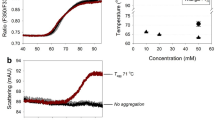Abstract
Purpose
The aim of this study was to markedly lower the viscosities of highly concentrated protein, in particular antibody, formulations. An effective approach elaborated herein for γ-globulin and a monoclonal antibody is to replace aqueous solutions with equimolar suspensions in neat organic solvents.
Methods
Viscosities of aqueous solutions and non-aqueous suspensions of the model protein bovine γ-globulin and a murine monoclonal antibody were examined under a variety of experimental conditions. In addition, protein particle sizes were measured using dynamic light scattering and light microscopy.
Results
Concentrated suspensions of amorphous γ-globulin powders (up to 300 mg/mL, composed of multi-micron-sized particles) in absolute ethanol and a number of other organic solvents were found to have viscosities up to 38 times lower than the corresponding aqueous solutions. Monoclonal antibody follows the same general trend. Additionally, the higher the protein concentration and lower the temperature, the greater the viscosity benefit of a suspension over a solution.
Conclusions
The viscosities of concentrated γ-globulin and monoclonal antibody suspensions in organic solvents are drastically reduced compared to the corresponding aqueous solutions; the magnitude of this reduction depends on the solvent, particularly its hydrogen-bonding properties.




Similar content being viewed by others
Abbreviations
- MAb:
-
Monoclonal antibody
References
Beck A, Wurch T, Bailly C, Corvaia N. Strategies and challenges for the next generation of therapeutic antibodies. Nature Revs Immunol. 2010;10:345–52.
Weiner LM, Surana R, Wang S. Monoclonal antibodies: versatile platforms for cancer immunotherapy. Nature Revs Immunol. 2010;10:317–27.
Ahamed T, Esteban BNA, Ottens M, van Dedem GWK, van der Wielen LAM, Bisschops MAT, et al. Phase behavior of an intact monoclonal antibody. Biophys J. 2007;93:610–9.
Yang MX, Shenoy B, Disttler M, Patel R, McGrath M, Pechenov S, et al. Crystalline monoclonal antibodies for subcutaneous delivery. Proc Natl Acad Sci U S A. 2003;100:6934–9.
Shire SJ, Shahrokh Z, Liu J. Challenges in the development of high protein concentration formulations. J Pharm Sci. 2004;93:1390–402.
Du W, Klibanov AM. Hydrophobic salts markedly diminish viscosity of concentrated protein solutions. Biotechnol Bioeng. 2011;108:632–6.
Guo Z, Chen A, Nassar RA, Helk B, Mueller C, Tang Y, et al. Structure-activity relationship for hydrophobic salts as viscosity-lowering excipients for concentrated solutions of monoclonal antibodies. Pharm Res. 2012;29:3102–9.
Miller MA, Engstrom JD, Ludher BS, Johnston KP. Low viscosity highly concentrated injectable nonaqueous suspension of lysozyme microparticles. Langmuir. 2010;26:1067–74.
Johnston KP, Maynard JA, Truskett TM, Borwankar AU, Miller MA, Wilson BK, et al. Concentrated dispersion of equilibrium protein nanoclusters that reversibly dissociate into active monomers. ACS Nano. 2012;6:1357–69.
Basu SK, Govardhan CP, Jung CW, Margolin AL. Protein crystals for the delivery of biopharmaceuticals. Expert Op Biol Ther. 2004;4:301–17.
He F, Becker GW, Litowski JR, Narhi LO, Brems DN, Razinkov VI. High throughput dynamic light scattering methods for measuring viscosity of concentrated protein solutions. Anal Biochem. 2010;399:141–3.
Krieger IM, Dougherty TJ. A mechanism for non-Newtonian flow in suspensions of rigid spheres. Trans Soc Rheol. 1959;3:137–52.
Patel AR, Kerwin BA, Kanapuram SR. Viscoelastic characterization of high concentration antibody formulations using quartz crystal microbalance with dissipation monitoring. J Pharm Sci. 2009;98:3108–16.
Kanai S, Liu J, Patapoff HW, Shire SJ. Reversible self-association of a concentrated monoclonal antibody solution mediated by Fab-Fab interaction that impacts solution viscosity. J Pharm Sci. 2008;97:4219–27.
Yadav S, Shire SJ, Kalonia DS. Factors affecting the viscosity in high concentration solutions of different monoclonal antibodies. J Pharm Sci. 2010;99:4812–29.
Patel HM, Kraszewski JL, Mukhopadhyay B. The phosphoenolpyruvate carboxylase from Methanothermobacter thermautotrophicus has a novel structure. J Bacteriol. 2004;186:5129–37.
Englard S, Seifter S. Precipitation techniques. Meth Enzymol. 1990;182:285–300.
Matheus S, Friess W, Schwartz D, Mahler H-C. Liquid high concentration IgG1 antibody formulations by precipitation. J Pharm Sci. 2009;98:3043–57.
Frokjaer S, Otzen DE. Protein drug stability: a formulation challenge. Nature Revs Drug Discov. 2005;4:298–306.
Van Oss CJ. On the mechanism of the cold ethanol precipitation method of plasma protein fractionation. J Protein Chem. 1989;8:6661–8.
Klibanov AM. Improving enzymes by using them in organic solvents. Nature. 2001;409:241–6.
Foster TP, Moseley WM, Caputo JF, Alaniz GR, Leatherman MW, Yu X, et al. Sustained elevated serum somatotropin concentrations in Holstein steers following subcutaneous delivery of a growth hormone releasing factor analog dispersed in water, oil or microspheres. J Control Rel. 1997;47:91–9.
FDA. Inactive ingredient search for approved drug products. November 23, 2012. Available from: http://www.accessdata.fda.gov/scripts/cder/iig/index.cfm.
Bowen M, Armstrong N, Ma Y-F. Investigating high-concentration monoclonal antibody powder suspension in nonaqueous suspension vehicles for subcutaneous injection. J Pharm Sci. 2012;101:4433–43.
Dai W, Hill B, Liu K, Mieczkowski C. Non-aqueous high concentration reduced viscosity suspension formulations of antibodies. US Patent Application 2012; 0 076 800.
Acknowledgments and Disclosures
This study was financially supported by the Sanofi-Aventis pharmaceutical company. We also thank the MIT Biophysical Instrumentation Facility for the Study of Complex Macromolecular Systems (funded by NSF-0070319 and NIH GM68762 instrumentation grants).
Author information
Authors and Affiliations
Corresponding author
Rights and permissions
About this article
Cite this article
Srinivasan, C., Weight, A.K., Bussemer, T. et al. Non-Aqueous Suspensions of Antibodies are Much Less Viscous Than Equally Concentrated Aqueous Solutions. Pharm Res 30, 1749–1757 (2013). https://doi.org/10.1007/s11095-013-1017-4
Received:
Accepted:
Published:
Issue Date:
DOI: https://doi.org/10.1007/s11095-013-1017-4




